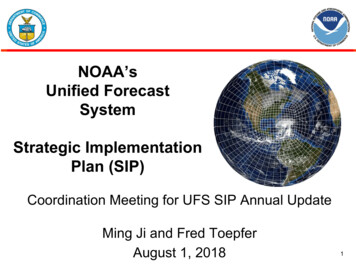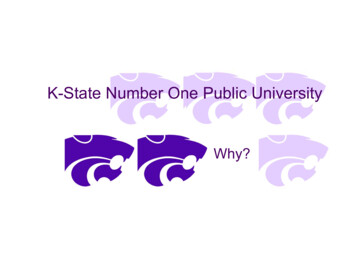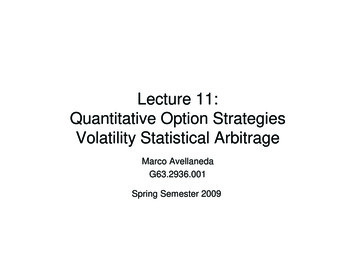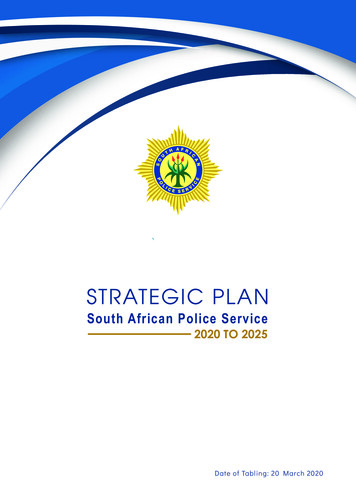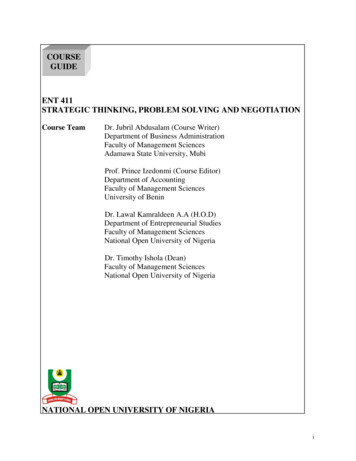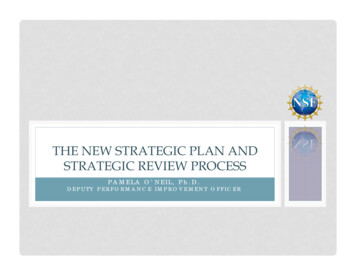
Transcription
watershed information center & conservancy2007-08STRATEGIC PLANJUNE 2007of napa county
Watershed Information Center and Conservancy Boardof Napa County2007-08 Strategic PlanAcknowledgementsNapa County Conservation Development and Planning DepartmentHillary Gitelman, DirectorPatrick Lowe, Deputy DirectorJeff Sharp, Principal PlannerLaura Anderson, County Counsel1195 Third Street, Suite 210Napa, CA 94559(707) 253-4417http://www.co.napa.ca.usNapa County Board of SupervisorsBrad Wagenknecht, District 1Mark Luce, District 2Diane Dillon, District 3Bill Dodd, District 4Harold Moskowite, District 5Watershed Information Center and Conservancy Board of Napa CountyMemberDon Gasser, ChairSteven Rosa, Vice ChairPhill BlakeKate DarganDiane DillonLeon GarciaJim KingGary KrausMark LucePeter Mott*Michael Novak*Mark PandoneJeffrey ReddingJeff ReichelChris SauerCharles SlutzkinRobert SteinhauerHarold Moskowite, AlternateAffiliationNapa Resource Conservation DistrictYountville Town CouncilNatural Resource Conservation ServicePublic at LargeNapa County Board of SupervisorsAmerican Canyon City CouncilNapa County Planning CommissionCalistoga City CouncilNapa County Board of SupervisorsNapa City CouncilSt. Helena City CouncilPublic at LargePublic at LargeLand Trust of Napa CountyPublic at LargePublic at LargePublic at LargeNapa County Board of Supervisors*Pending confirmationProject ConsultantMary Selkirk, Associate - Senior MediatorAustin McInerny, Associate - Lead MediatorCenter for Collaborative PolicyCalifornia Sate University, Sacramento815 S Street, Suite 100Sacramento, CA 95814(916) 445-2079http://www.csus.edu/ccpPrint Date: 10/02/2007Page 1 of 11
Watershed Information Center and Conservancy Boardof Napa County2007-08 Strategic PlanTable of ContentsAcknowledgements1Table of Contents2Strategic Plan3Role and Responsibility3Vision 20253Guiding Principles4Strategic Plan Focus Areas4Watershed Conservation & Management (WCM)5Watershed Information Center & Conservancy Website (WEB)6Communication, Coordination & Partnerships (CCP)7Education & Outreach (EDU)8Organizational Structure & FundingAppendix1011Organizational DiagramA-1Organizational ChartA-2Coordinating and Staff Support DiagramA-3Example Support Roles for Coordinating StaffA-4Print Date: 10/02/2007Page 2 of 11
Watershed Information Center and Conservancy Boardof Napa County2007-08 Strategic PlanWatershed Information Center and Conservancy (WICC) of Napa County2007-08 Strategic PlanJune 2007Mission StatementThe Watershed Information Center and Conservancy (WICC) of Napa County educates and supports thecommunity in its efforts to maintain and improve the health of Napa County’s watershed lands.Role and ResponsibilityThe WICC Board serves as an advisory committee to Napa County Board of Supervisors. The role of the WICCis to assist the Board of Supervisors in their decision-making process and serve as a conduit for citizen input bygathering, analyzing and recommending options related to the management of watershed resources. In thatcapacity, the WICC has a responsibility to publicly evaluate and discuss matters they have been requested toreview and comment upon by the Board of Supervisors. The WICC is not authorized to sign contracts, disbursefunds, implement programs, employ or consider any personnel matter or act in any other capacity that involvesthe direct management or operation of a County program. The Board of Supervisors has charged the WICC(under Resolution 02-103 and through verbal direction) with making recommendations to the Board ofSupervisors on matters relating to watershed restoration projects and resource protection activities, coordinationof land acquisition, and development of a long-term watershed resource management program providing publicoutreach and education, monitoring coordination, inventory and assessment, anddata management.Vision 2025"Napa County’s watersheds will maintain a balance of natural processes to support healthy native fisheries, anabundance of native plants and wildlife, and water quality that meets state standards. The Napa River and itstributaries, no longer listed as impaired, will be a nation-wide example of what a community, working together,can do to improve the health of its watersheds.The Watershed Information Center and Conservancy of Napa County will be a guiding force in creating a shared,community-wide understanding of Napa County’s watershed lands. Having educated a generation of communitymembers about the county’s watersheds, all of Napa County’s residents will be conscious of the critical balancebetween agriculture and development, and ecological and natural processes that must be maintained in order toassure continued watershed health.A network of active creek and land stewardship groups and watershed organizations will carry out watershedmonitoring, enhancement projects and management activities. The majority of the County’s watershed lands willbe certified as “Watershed-Friendly” and those landowners will be among the most conscious of watershedstewards, consistently monitoring and managing their lands for watershed health.The state-of-the-art WICC WebCenter will be accessible, understandable and user friendly, allowing everyonefrom school children to scientists access to the most current, valid and vivid information about Napa County’swatersheds. This accurate and straightforward information will allow users to weigh scientific facts and recognizecommunity values to make well-informed management decisions."Print Date: 10/02/2007Page 3 of 11
Watershed Information Center and Conservancy Boardof Napa County2007-08 Strategic PlanGuiding Principles1. The WICC collects and disseminates the best possible information to aid decision-making and is part of thesolution to watershed issues and concerns.2. The WICC provides tools, information and education so that all members of the community can discover andunderstand their watershed.3. Collaboration is the most effective way to accomplish the mission of the WICC. All organizations andindividuals working to restore and enhance Napa County’s watersheds are encouraged to participate in theWICC.4. The WICC supports the restoration activities of other watershed restoration organizations and facilitatescooperation among them.5. Participation in the WICC and provision of information to the WICC WebCenter is done voluntarily byagencies, organizations, and individuals.6. The WICC seeks and accepts funding from foundations, private individuals, organizations, and local, state,and federal government to address its financial needs and to further its mission and goals.7. Actions by the WICC remain politically neutral to successfully accomplish its mission and vision for NapaCounty's watershedsStrategic Plan Focus AreasThis plan is organized into five planning focus areas. Each area includes a Goal, Strategies, Potential Measuresof Success and Suggested Strategic Plan Actions. The focus areas are not mutually exclusive and should beconsidered complementary to one another and to the overall mission of the WICC. The five focus areasconsidered for strategic planning purposes are:Watershed Conservation & Management (WCM)Watershed Information Center and Conservancy Website (WEB)Communication, Coordination & Partnerships (CCP)Education & Outreach (EDU)Organizational Structure and Funding (OSF)Print Date: 10/02/2007Page 4 of 11
Watershed Information Center and Conservancy Boardof Napa County2007-08 Strategic PlanWatershed Conservation & Management (WCM)GoalImprove watershed health throughout the entirety of Napa County, which includes its cities and towns, by supportingcommunity efforts to protect and enhance all watershed lands and natural processes with an emphasis on ripariancorridors and native species and their habitats.Strategies Identify, conduct and coordinate watershed studies and monitoring that will improve the community’s understanding and management of itswatershed resources. Identify key watershed areas for restoration, enhancement, and/or permanent protection. Work with and support landowners, citizen organizations, districts and agencies to permanently protect key watershed lands.Potential Measures of Success (*) Removal of Napa County's "water quality limited" water bodies from California’s Sec. 303(d) list established under the Clean Water Act. Implementation of long-term/baseline monitoring as identified in a countywide Watershed Monitoring Strategy. Implementation of improved management practices based upon monitoring results, feedback and adaptive management principles. Development of a specified number of creek/drainage management/enhancement plans. Miles of creek restored and/or fish barriers removed. Increased numbers and vitality of native fish populations. Number of acres maintaining a ‘natural fire cycle’ status. Identification of lands actively improving native species growth.(*) Measures of Success will be quantified as detailed plans for each action are developed.Suggested Strategic Plan ActionsPriority One ActionsPriority Two ActionsPriority Three ActionsAs-Needed ActionsAction WCM1: Assist with thedevelopment and implementationof a streamlined permittingprocess.Action WCM2 (Recurring):Provide monthly updates on theWICC WebCenter about thestatus of the WatershedMonitoring Strategy and theWatershed Management Strategy.Action WCM4: Initiate a programsupported by the WICC thatidentifies and publicizes “HealthyWatershed Demonstration Sites”for residential, agricultural, andbusiness properties.Action WCM5: Support the LandTrust of Napa County and otherpotential conservation easementholders with easement acquisitionefforts.Action WCM3: Complete theCountywide WatershedManagement Strategy. Prioritizeand incorporate the recommendedmanagement actions into theWICC's Strategic Plan.Print Date: 10/02/2007Page 5 of 11
Watershed Information Center and Conservancy Boardof Napa County2007-08 Strategic PlanWatershed Information Center & Conservancy Website (WEB)GoalMaintain an understandable, interesting, and user friendly website that provides high-quality environmental data andinformation allowing the community to better understand and manage the County’s watersheds.Strategies Increase community awareness of the information and services available via the WICC WebCenter (www.napawatersheds.org). Ensure that the data and information on the WICC WebCenter is accurate and current so that it is most effective in informing decisions andmeeting community's needs.Potential Measures of Success (*) Number of webpage hits & quantity of information exchanged. Number of organizations hosted/linked on the WICC WebCenter. Number of calendar events posted. Number of individual users registered on the WICC WebCenter.(*) Measures of Success will be quantified as detailed plans for each action are developed.Suggested Strategic Plan ActionsPriority One ActionsPriority Two ActionsPriority Three ActionsAs-Needed ActionsAction WEB1: Continuallyimprove upon the WICCWebCenter, making it more userfriendly and attractive.Action WEB2 (Recurring): On amonthly basis add any new data tothe WICC WebCenter that hasbeen developed and maintain thewebsite as necessary.Action WEB5 (Recurring):Annually survey a cross sectionWICC WebCenter users includingwatershed organizations,educators, urban and ruralresidents and members of theagricultural community to identifywhat works well and what needsimproving. Conduct this surveyprior to implementing the annualStrategic Plan update andincorporate agreed-upon changesinto the revised Strategic Plan(and ultimately the WebCenter).Action WEB7: As neworganizations register on theWICC WebCenter, gather thefollowing information to beincorporated into the WebCenter:a) Links from the WICCWebCenter to the organization’swebsite; b) Roles and services thathe organization provides; c)Watershed projects (monitoring,restoration, and enhancement),studies and educational effortsbeing conducted by theorganization; and d) If available,provide an additional link from theWICC WebCenter's volunteeractivities section to eachorganization’s volunteeropportunities section.Action WEB3 (Recurring):Update the website annually toreflect the comments receivedfrom the WICC's Community andTechnical Advisory Committees.Action WEB6 (Recurring):Request an annual review of theWICC WebCenter by theTechnical Advisory Committee(TAC) to identify what works welland what needs improving from atechnical and scientific userperspective. Conduct this surveyprior to implementing the annualStrategic Plan update andincorporate agreed-upon changesinto the revised Strategic Plan, aswell as the WebCenter.Action WEB4: Solicit sponsors forthe WICC WebCenter.Print Date: 10/02/2007Page 6 of 11
Watershed Information Center and Conservancy Boardof Napa County2007-08 Strategic PlanCommunication, Coordination & Partnerships (CCP)GoalBuild and strengthen effective partnerships to foster communication, coordination and involvement among all thoseworking to improve the health of Napa County’s watersheds.Strategies Coordinate and facilitate watershed planning, research, and monitoring efforts among Napa County organizations, agencies, landowners, andcitizen organizations to limit gaps and overlaps and improve consistency between watershed-related activities. Support organizations with a watershed restoration focus. Serve as a clearinghouse and coordinator for watershed activities and involvement.Potential Measures of Success (*) Number of watershed-related projects that involve partnerships. Number of organizations contributing to WICC WebCenter. Number of organizations participating in the WICC's “CommunityAdvisory Committee.” Number of new grants funded through increased involvement,coordination and leveraging among watershed organizations.(*) Measures of Success will be quantified as detailed plans for each action are developed.Suggested Strategic Plan ActionsPriority One ActionsPriority Two ActionsPriority Three ActionsAs-Needed ActionsAction CCP1 (Recurring):Provide training in the use of theWICC WebCenter to localwatershed groups. Seek feedbackfrom these organizations regardingways to improve the website tomeet watershed stewardshipneeds, as well as the changingneeds of the community.Action CCP3 (Recurring):Annually survey each watershedrelated organization contributing tothe WICC to identify watershedprojects (monitoring, restoration,and enhancement), watershedassessments, studies andeducational efforts beingconducted throughout NapaCounty. Post this information onthe WICC WebCenter to alloworganizations to coordinate andcollaborate more effectively on awide range of watershed projectsand activities. Maintain andannually update this information toidentify overlaps and gaps inprojects, activities, and servicesprovided by these organizations,and ways in which the WICCcould remedy these gaps andoverlaps. Consider including theareas of greatest need as futurepriority actions in the WICCStrategic Plan.Action CCP5: Establish a WICC“Community Advisory Committee"where interested communitymembers, organizations,watershed groups, and landmanagers could come together todiscuss projects and programsthroughout the County’swatersheds. This AdvisoryCommittee would also serve as anetworking opportunity for thesegroups and individuals to meet anddiscuss potential opportunities forcollaboration. It also provides ahome for ongoing communitydiscussions about the pros andcons of various approaches towatershed management.Action CCP8: Providerecommendations to the Board ofSupervisors for letters of supportto watershed organizationsseeking grant funding.Recommendation for support fromthe WICC indicates broadcommunity support for watershedproposals and will increase thelikelihood of project funding.Action CCP2 (Recurring):Provide annual updates to Cityand Town councils of NapaCounty on WICC activities,program and resources.Action CCP4: Develop and poston the WICC WebCenter adirectory of watershedorganizations and partnerships.Action CCP6: Hold a grant-writingseminars for watershedorganizations.Action CCP7: Create a section ofthe WICC WebCenter dedicatedto assisting local watershed groupswith increasing organizationaleffectiveness and capacity.Print Date: 10/02/2007Page 7 of 11
Watershed Information Center and Conservancy Boardof Napa County2007-08 Strategic PlanEducation & Outreach (EDU)GoalEnable the community - those who live in, work in and visit the County's watersheds - to understand the importance ofwatershed stewardship and watershed health and be actively involved in improving the health of the County'swatersheds.Strategies Provide targeted watershed conservation and stewardship-related education and information to various subsets of the community including theagricultural community, educators, urban and rural residents, and sub-watershed organizations of Napa County. Support appropriate public access to Napa County’s watershed lands where suitable to build appreciation and understanding of the County'swatersheds and their resources.Potential Measures of Success (*) Numbers of presentations to community organizations/groups. Number of respondents to WICC online surveys. Number of watershed events listed on the monthly calendar. Participation in events celebrating Watershed Awareness Month. Number of Napa County students and classroom groups thatparticipate in watershed-related education programs. Number of brochures distributed in target audience categories. Establishment of Watershed Demonstration Sites for agricultural,residential and commercial properties. Number of sub-watershed stewardship groups established in NapaCounty. Number of homeowners, farmers, vintners, grape growers, andbusiness owners participating in various known watershed stewardshipand conservation programs. Number of individuals participating in watershed hikes, outings andguided tours of the County's watershed lands.(*) Measures of Success will be quantified as detailed plans for each action are developed.Suggested Strategic Plan ActionsPriority One ActionsPriority Two ActionsPriority Three ActionsAction EDU1 (Recurring):Update the watershed eventscalendar on a weekly basis.Include all watershed relatedevents including seminars;monitoring and volunteer days;opportunities for residents toattend guided tours of watershedlands and demonstration projects;and watershed festivals andrelated public events.Action EDU4: Implement targeted Action EDU6: Implement aeducation and outreach strategytargeted education and outreachfor educators and students.strategy for agriculturalists.Action EDU2: Provide informationto the community on regionalissues such as TMDL’s andrelated State water quality policies,as well as the directive of theRegional Water Quality ControlBoard to promote water qualityobjectives outlined in the Region's(SF Bay and Central Valley) BasinPlan(s) as required under theClean Water Act throughout thewaters of Napa County.Action EDU5: Work with theNapa County ResourceConservation District (RCD) andsimilar organizations to identifycreeks/drainages in Napa Countywithout a watershed stewardshipgroups. Create a mailing list oflandowners within these subwatershed drainages and providesupport to the RCD and others toestablish watershed stewardshipgroups and watershed programswithin these areas.Action EDU3: Implement atargeted education and outreachstrategy for urban and ruralresidents.Print Date: 10/02/2007As-Needed ActionsAction EDU7: Work withwatershed organizations andagencies that are currentlyproviding educational programmingand curricula to schools to identifyopportunities to expand existingprograms and build connectionswith the watershed stewardshipand watershed demonstration siteprograms.Action EDU8: Establish apermanent physical location for theWICC.Page 8 of 11
Watershed Information Center and Conservancy Boardof Napa County2007-08 Strategic PlanEducation & Outreach (EDU)Suggested Strategic Plan Actions (Cont.)Priority One ActionsPriority Two ActionsPriority Three ActionsAs-Needed ActionsAction EDU9: Establish a“Watershed Stewards Program”based upon watershed-relatedbest management practices thatparticipants would implementbased upon property type and use.Action EDU10: Implement atargeted education and outreachstrategy for watershed groups.Print Date: 10/02/2007Page 9 of 11
Watershed Information Center and Conservancy Boardof Napa County2007-08 Strategic PlanOrganizational Structure and Funding (OSF)GoalObtain adequate resources and establish the appropriate organizational structure to ensure the WICC’s long-termsuccess.Strategies Secure reliable long-term (i.e., permanent) funding to fulfill the mission and goals of the WICC. Develop adequate coordination and management staff, Board membership, volunteers, and Community and Technical Advisory Committeeparticipation, to guide, support and conduct WICC activities. Establish an organizational structure that suits the mission and goals of the WICC.Potential Measures of Success (*) Dollars acquired through grant funding in support of WICC activities. Permanent physical (visual and accessible) location for WICC. Dollars of sustained local (i.e., County, City, District) funding. Dollars acquired from all forms of fundraising. Number WICC coordinating staff. Dollars acquired from charitable donations, gifts and foundations.(*) Measures of Success will be quantified as detailed plans for each action are developed.Suggested Strategic Plan ActionsPriority One ActionsPriority Two ActionsPriority Three ActionsAs-Needed ActionsAction OSF10: Convene ad-hoccommittees as needed to addressspecial watershed managementissues.Action OSF1: Identify potentialgrant opportunities and sources offunding for the Priority 1 actions inthe 2007-08 WICC Strategic Plan.Action OSF4: Identify fundingsources for staff and projectrelated funding includingmaintenance of the WICCWebCenter and funding for aphysical WICC office.Action OSF7: At each WICCBoard Meeting dedicate a portionof the meeting to educating theboard on watershed-related issuesand potential WICC roles inaddressing these issues andwatershed managementopportunities.Action OSF2 (Recurring):Provide an annual update to theNapa County Board ofSupervisors and City and TownCouncils about the currentactivities and successes of theWICC. Update should stress thebenefits and values of the WICCto the community.Action OSF5 (Recurring):Annually update the WICCStrategic Plan. Revisit actionsfrom the prior years plan, identifynew actions as needed andreprioritize all actions. Assigntimeframes and responsibilities toeach action. Identify potentialsources of funding for eachPriority 1 item.Action OSF8: Hold a WICCBoard session to evaluate the prosand cons of the WICC holdingconservation easements. Shouldthe WICC Board decide that itdoes not want to hold easementsof any type, consider changing thename of the organization to theWIC (Watershed InformationCenter) thereby deleting theConservancy portion of the titlethat relates to land conservation.Action OSF3: Identify and initiateactions needed to implement theWICC's new organizationalstructure as depicted on theWICC's Organizational Chart;including development of aMemorandum of Understandingbetween the County, Cities, Townand Districts interested insupporting the WICC as anAdvisory Board to their respectiveorganizations.Further explore the establishmentof a nonprofit arm or "foundationfund" for the WICC to facilitate theacceptance of charitable donationsin support of the WICC's missionand goals.OS6: Explore additional fundingAction OSF9: Develop a strategysources including donations andto recruit and train WICCsponsorships, membership dues,volunteers.fee for service opportunities,fundraising, dedicated funding andopen space district funding, oncethe district is formed.Print Date: 10/02/2007Page 10 of 11
Watershed Information Center and Conservancy Boardof Napa County2007-08 Strategic PlanAppendixTable of ContentsOrganizational DiagramA-2Organizational ChartA-3Coordinating and Staff Support DiagramA-4Example Support Roles for Coordinating StaffA-5Print Date: 10/02/2007Page 11 of 11
Watershed Information Center and Conservancy Board of Napa CountyPrint Date: 10/02/2007Many Contribute to the Success of the WICCThe commitment and involvement of these and many others contributes directlyto the merit and achievement of the WICC’s missionNapa CountyCities & TownLandowners,WatershedStewardships& CitizenOrganizationsFlood & WaterConservationDistrictWICCNapa CountyResourceConservationDistrictState &FederalAgenciesLocalAgencies &DistrictsDefining a supportive and adaptive Watershed Information Center and Conservancy Board for Napa CountyA-1
Watershed Information Center and Conservancy Board of Napa CountyPrint Date: 10/02/2007WICC Organization ChartPublicBoard ofSupervisorsCities &TownFlood Dist.BoardWatershed Information Center &Conservancy (WICC) Advisory BoardCommunityTechnicalWatershed Stewardships/Groups (RDRT, Selby,Carneros, Sulphur, AcornSoupe, FONR, Sierra Club,ICARE, NSWG & othersAgency & Academic Experts(RWQCB, NOAA, CC, RCD,NRCS, CDF, ACoE, DFG,FWS, UC/CSU & others)County, City & District Coordinating StaffElectedAppointedAd HocAdvisoryCommitteesWatershedGroups &AgenciesRegularCoordinationMtgs.Defining a supportive and adaptive Watershed Information Center and Conservancy Board for Napa CountyA-2
Watershed Information Center and Conservancy Board of Napa CountyPrint Date: 10/02/2007Coordinating and Support StaffRegularCoordinationMtgs.County, City & District Coordinating StaffCountyConservationDevelopment& PlanningDept.Napa CountyResourceConservationDistrictLand UsePlanningMonitoring ervationRegulationsWatershedStewardship &EducationAgriculturalErosion ControlProject /DevelopmentPermittingCounty NaturalResource &EnvironmentalDataRestorationDesign &ImplementationFlood Control& WaterConservationDistrictCounty-wideNPDES ProgramSponsorWatershed /GroundwaterMonitoringWatershedMaintenance &OperationsNapa FloodProjectProject FundingErosion ControlConsultationCountyDepartment ofPublic WorksCountyDepartment ofEnvironmentalManagementCounty MeasureA ProgramsWater QualityMonitoringFlood PlainManagement /PermittingOn Site WasteWater SystemsGroundwaterOrdinance /PermittingCounty RoadMaintenanceFlood StudiesNPDESImplementationState WaterContracts &SupplyGrading /ConstructionErosion ControlHazardousMaterialsCities &TownSupportingStaff/Depts.County-wideNPDES ProgramParticipantFlood Control /PlanningCity RoadMaintenanceWell Monitoring &PermittingWater nty MaterialsRecyclingProgramWater Re-use /RecyclingOther ProgramsDefining a supportive and adaptive Watershed Information Center and Conservancy Board for Napa CountyA-3MOUCounty,Cities, Town& DistrictsVariousRelatedProgramAreas
Watershed Information Center and Conservancy Board of Napa CountyPrint Date: 10/02/2007Example Support Roles for Coordinating Staff Coordinating Staff would facilitate and enable the WICC to serve as an advisory board to Board of Supervisors, Flood and WaterConservation Board, and City and Town Councils. The County Conservation Development and Planning Department (Conservation Division) would coordinate a Memorandum ofUnderstanding (MOU) between the County, Cities, Town and Districts interested in supporting the WICC as an Advisory Board totheir respective organizations. Individual organizations under the MOU, as well as those participating in the Community Advisory Committee (CAC), may holdgrants and/or contracts for work in the interest of the WICC. MOU agencies (Coordinating Staff) would meet monthly to discuss related project areas and coordinate staff support for the WICCBoard and its advisory committees. MOU agencies (Coordinating Staff) would participate in cooperatively reviewing requests (and application) for funding, collaborateon Integrated Regional Water Management Planning (IRWMP), and work together to better define and provide available services towatershed and stewardship groups throughout Napa County. JPAs or other contracts/agreements among MOU agencies may exist to provide efficiencies where needed but would beindependent of WICC. The Napa County Resource Conservation District (RCD) would facilitate the Community and Technical Advisory Committees on anad hoc (as needed) basis. At minimum the Community and Technical Advisory Committees would meet quarterly.Defining a supportive and adaptive Watershed Information Center and Conservancy Board for Napa CountyA-4
The role of the WICC is to assist the Board of Supervisors in their decision-making process and serve as a conduit for citizen input by gathering, analyzing and recommending options related to the management of watershed resources. In that capacity, the WICC has a responsibility to publicly evaluate and discuss matters they have been requested to

